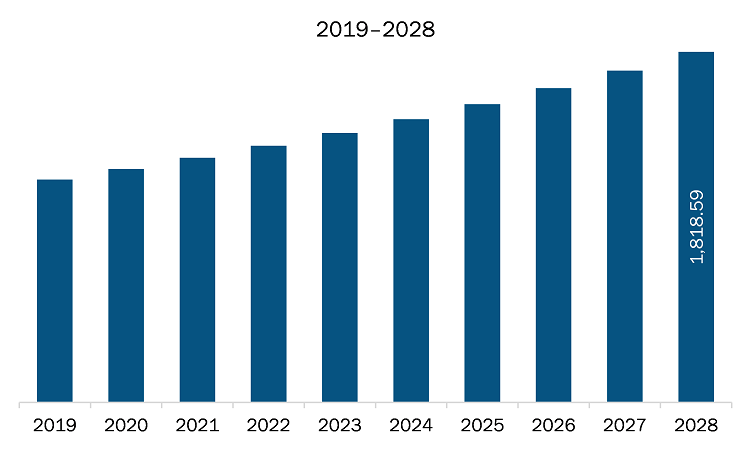The soluble dietary fibers market in Asia Pacific is expected to grow from US$ 1,268.88 million in 2021 to US$ 1,818.59 million by 2028; it is estimated to grow at a CAGR of 5.3% from 2021 to 2028.
As per the Department of Health, Australia, soluble fibers such as pectins, gums, and mucilage are significantly sourced from fruits and vegetables, oat bran, barley, seed husks, flaxseed, psyllium, dried beans, lentils, peas, and soy milk and soy products. Apart from the traditional sources of soluble dietary fibers, new sources of soluble dietary fibers have been identified. According to an article published by Multidisciplinary Digital Publishing Institute (MDPI) in 2020, the water-soluble fibers such as mucilage, can also be obtained from aquatic plants, cactus, aloe vera, and okra, as well as glycoproteins from food additives. For instance, an article published by NCBI justifies cactus being rich source of dietary fibers. The water-soluble dietary fiber (SDF) obtained from cactus (opuntia streptacantha) shows a potential to suppress the effect for elevation of postprandial blood glucose level. Similarly, seaweed extracts, such as carrageenan, are also considered one of the essential sources of soluble dietary fibers. Carrageenan is effective in maintaining the cholesterol content in foods, owing to its ability to mimic the texture and sensory qualities of fat, which helps to significantly reduce the total amount of fat in food. Similarly, several studies suggest that soluble dietary fibers can be extracted from brown algae. An article published by NCBI in June 2020 states that the soluble fiber content is comparatively higher in red algae (15–22% dry weight) as in Chondrus and Porphyra. In the wake of rising demand for soluble dietary fibers, several manufacturers are trying to invest and explore new sources of such fibers. For instance, Sobigel is involved in production of superior quality dietary agar possessing solubility of up to 85%, which can regulate intestinal flow, control cholesterol and sugar levels, and manage overweight. Owing to its capacity of absorbing water, it is considered as an ideal ingredient to be used in food supplements and cooking purposes. Hence, the soluble dietary fibers market is expected to flourish with the evolution of new sources.
The COVID-19 pandemic is anticipated to cause a significant economic loss in Asia Pacific. The consequence and impact can be even worse, and they totally depend on the spread of the virus. The Asian economies have been hit hard due to the pandemic. The emergence of new COVID-19 waves in India, Thailand, and other Asian economies has prolonged the effect of pandemic upon GDP. The ongoing COVID-19 pandemic is anticipated to cause huge disruptions in the growth of various industries of Asia Pacific. However, the uncertainty regarding the future outbreak, especially in countries such as India and few other Asian countries, has altered the status of several industrial sectors. The governments of various Asia Pacific economies are taking possible steps to restrict the spread of the virus by announcing country-wide lockdown, which have a direct impact upon the growth of industrial sectors. This may impact the demand for soluble dietary fibers. However, the market is expected to witness an increase in investment by existing players along with penetration of new players to tap the prevailing opportunities as well as cater to soaring demand for natural, healthy, clean-label products in post-pandemic times.
With the new features and technologies, vendors can attract new customers and expand their footprints in emerging markets. This factor is likely to drive the Asia Pacific soluble dietary fibers market. The Asia Pacific soluble dietary fibers market is expected to grow at a good CAGR during the forecast period.

- This FREE sample will include data analysis, ranging from market trends to estimates and forecasts.
Asia Pacific Soluble Dietary Fibers Market Segmentation
Asia Pacific Soluble Dietary Fibers Market – By Type
- Inulin
- Pectin
- Beta-glucan
- Polydextrose
- Others
Asia Pacific Soluble Dietary Fibers Market – By Source
- Cereals and Grains
- Fruits and Vegetables
- Others
Asia Pacific Soluble Dietary Fibers Market – By Application
- Food and Beverages
- Animal Nutrition
- Pharmaceuticals and Nutraceuticals
- Others
Asia Pacific Soluble Dietary Fibers Market – By Country
- Australia
- China
- India
- Japan
- South Korea
- Rest of APAC
Asia Pacific Soluble Dietary Fibers Market – Companies Mentioned
- Cargill, Incorporated
- Kerry Group
- Ingredion Incorporated
- Nexira
- Tate & Lyle PLC
- ADM
- IFF Nutrition & Biosciences
- BENEO GmbH
- Roquette Frères
Asia Pacific Soluble Dietary Fibers Report Scope
| Report Attribute | Details |
|---|---|
| Market size in 2021 | US$ 1,268.88 Million |
| Market Size by 2028 | US$ 1,818.59 Million |
| CAGR (2021 - 2028) | 5.3% |
| Historical Data | 2019-2020 |
| Forecast period | 2022-2028 |
| Segments Covered |
By Type
|
| Regions and Countries Covered |
Asia-Pacific
|
| Market leaders and key company profiles |
|
- Historical Analysis (2 Years), Base Year, Forecast (7 Years) with CAGR
- PEST and SWOT Analysis
- Market Size Value / Volume - Regional, Country
- Industry and Competitive Landscape
- Excel Dataset
Recent Reports
Testimonials
Reason to Buy
- Informed Decision-Making
- Understanding Market Dynamics
- Competitive Analysis
- Identifying Emerging Markets
- Customer Insights
- Market Forecasts
- Risk Mitigation
- Boosting Operational Efficiency
- Strategic Planning
- Investment Justification
- Tracking Industry Innovations
- Aligning with Regulatory Trends






















 Get Free Sample For
Get Free Sample For